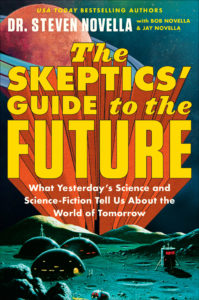Our Book | The Skeptics’ Guide to the Future | What Yesterday’s Science and Science Fiction Tell Us About the World of Tomorrow

Order Now!
Available September 27th
From the bestselling authors and hosts of “The Skeptics’ Guide to the Universe,” a high-tech roadmap of the future in their beloved voice, cracking open the follies of futurists past and how technology will profoundly change our world, redefining what it means to be human.
Our predictions of the future are a wild fantasy, inextricably linked to our present hopes and fears, biases and ignorance. Whether they be the outlandish leaps predicted in the 1920s, like multi-purpose utility belts with climate control capabilities and planes the size of luxury cruise ships, or the forecasts of the ‘60s, which didn’t anticipate the sexual revolution or women’s liberation, the path to the present is littered with failed predictions and incorrect estimations. The best we can do is try to absorb the lessons from futurism’s checkered past, perhaps learning to do a little better.
In THE SKEPTICS’ GUIDE TO THE FUTURE, Steven Novella and his co-authors build upon the work of futurists of the past by examining what they got right, what they got wrong, and how they came to those conclusions. By exploring the pitfalls of each era, they give their own speculations about the distant future, transformed by unbelievable technology ranging from genetic manipulation to artificial intelligence and quantum computing. Applying their trademark skepticism, they carefully extrapolate upon each scientific development, leaving no stone unturned as they lay out a vision for the future.
Praise for the Skeptics’ Guide

Kirkus review
THE SKEPTICS’ GUIDE TO THE UNIVERSE
How to Know What’s Really Real in a World Increasingly Full of Fake
[STARRED REVIEW!]
Why and how to become a skeptic. Steven Novella (Clinical Neurology/Yale Univ. School of Medicine), a founding fellow of the Institute for Science in Medicine and host and producer of the titular science and critical thinking podcast, pulls no punches in his attack on the misinformation, myths, and biases that surround us. Aided here by several writing associates, the author demonstrates his vast experience explaining the mechanisms of deception and the tactics used by pseudoscientists. To prepare readers, Novella first shows the ways in which our memories are faulty and our perceptions fallible, the glitches in our brains that trip us up, and the many logical fallacies that screw up our thinking. In lively, highly accessible prose, he helps readers understand these peculiarities and limitations and learn how to recognize deceptive claims. Science, he writes, is “the process of making our best effort to know what’s really real.” His chapters are filled with examples of pseudoscience and deception, some of which are old chestnuts, such as the “Clever Hans” effect. Others include intelligent design, pyramid schemes, exorcism, conspiracy theories, ghosts, and witches. Inevitably, some of Novella’s examples will challenge some readers’ treasured beliefs, but their inclusion here makes the challenges especially effective. As the author makes clear, some false beliefs come around again and again; new ones, however, confront us daily. A section on skepticism and the media, which looks at the difficulties of reporting science well, is rich with examples of science journalism gone wrong in the age of the internet and social media. Of special interest is the chapter on false balance, the common practice of TV news programs and documentaries giving equal coverage to two points of view that do not, in fact, have equal credibility; his prime example is climate change scientists debating climate change deniers. Presented as “one giant inoculation against bad science, deception, and faulty thinking,” the book succeeds superbly.








